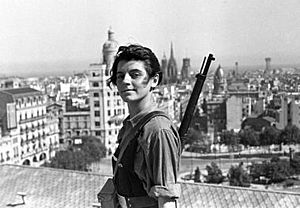Marina Ginestà facts for kids
Marina Ginestà i Coloma (born January 29, 1919 – died January 6, 2014) was a brave Spanish woman born in France. She was a member of a group called the Unified Socialist Youth. Marina became famous because of a special photo taken during the Spanish Civil War. This picture, taken by Juan Guzmán, shows her on a rooftop in Barcelona in 1936. It is now one of the most well-known images from that war.
Contents
Marina Ginestà's Early Life
Marina Ginestà was born in Toulouse, France, on January 29, 1919. Her family was working-class and believed in left-wing ideas, which meant they wanted society to be more equal for everyone. Both her parents, Empar Coloma Chalmeta and Bruno Ginestà Manubens, were tailors from Spain.
When Marina was 11 years old, she moved to Barcelona, Spain, with her family. She later joined a political group called the Unified Socialist Party of Catalonia. This group worked for social change and equality.
Marina's Role in the Spanish Civil War
When the Spanish Civil War started in 1936, Marina Ginestà helped out as a reporter and a translator. She worked with Mikhail Koltsov, who was a correspondent for a Soviet newspaper called Pravda. Her job was to help him communicate and report on the war.
Before the war ended, Marina was hurt and had to be moved to Montpellier, France, for safety.
Life After the War
When Nazi Germany took over France, Marina had to leave. She went to the Dominican Republic. There, she married a former officer from the Spanish Republic.
In 1946, she was forced to leave the Dominican Republic because of problems with the country's leader, Rafael Trujillo. She then moved to Venezuela.
In 1949, Marina divorced her husband and moved back to France. A few years later, in 1952, she married a Belgian diplomat and returned to Barcelona. Finally, in 1978, she moved to Paris, where she lived until she passed away. Marina Ginestà died in January 2014, at the age of 94.
The Famous Photograph
The well-known photo of Marina Ginestà was taken on July 21, 1936. It shows Marina, who was 17 years old at the time, wearing an army uniform. She is posing with a rifle on the roof of the original Hotel Colón in Plaça de Catalunya 9, Barcelona.
Details of the Picture
The picture was taken during the 1936 military uprising in Barcelona. The rifle Marina is holding is a type called an M1893 Spanish Mauser. These rifles were made in Spain for the Spanish Army.
Even though she is holding a gun in the photo, Marina was a reporter, not a soldier. She later said that this was the only time she ever carried a gun.
Impact of the Photograph
The picture was quickly published in a socialist newspaper. Over time, it became very popular. It is now seen as a powerful image of the Spanish Civil War. The photo represents the fight against fascism and the struggles of conflict.
Marina Ginestà herself spoke about the picture, saying: "It’s a good photo. It reflects the feeling we had at that moment. Socialism had arrived, the hotel guests had left. There was euphoria. We retired in Columbus, we ate well, as if bourgeois life belonged to us and we would have changed category quickly."
The famous photograph was also used on the cover of a book called Las Trece Rosas by Carlos Fonseca. The hotel where the picture was taken was destroyed after the war. Today, a building for the Banco Español de Crédito stands in its place.
See also
 In Spanish: Marina Ginestà para niños
In Spanish: Marina Ginestà para niños
- Carolina Bunjes
- Kozarčanka, World War II photograph showing a smiling female Partisan in Yugoslavia


